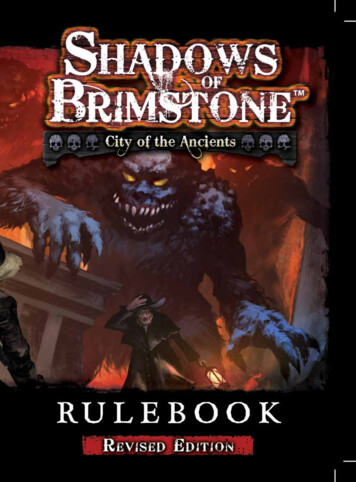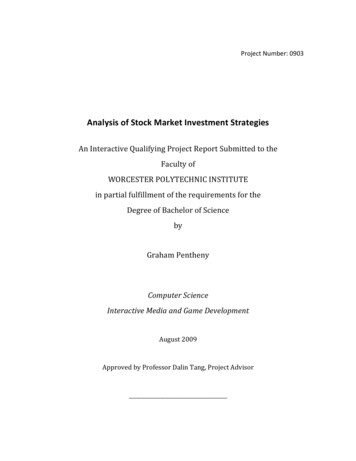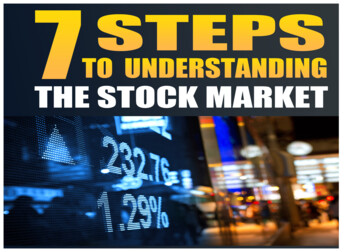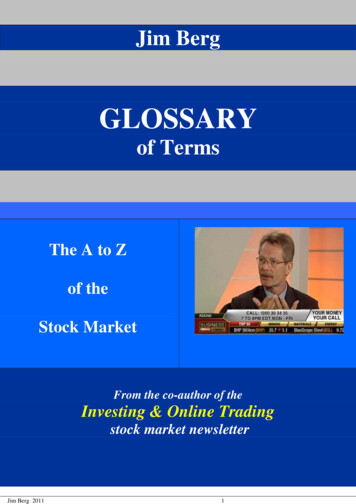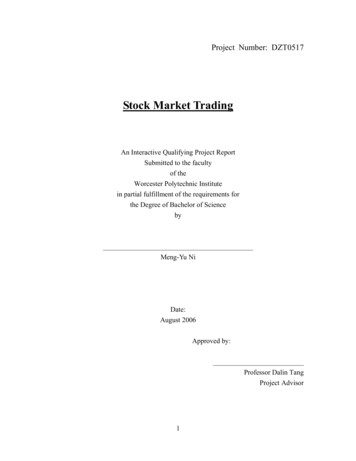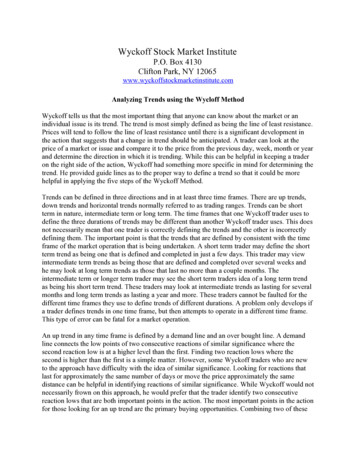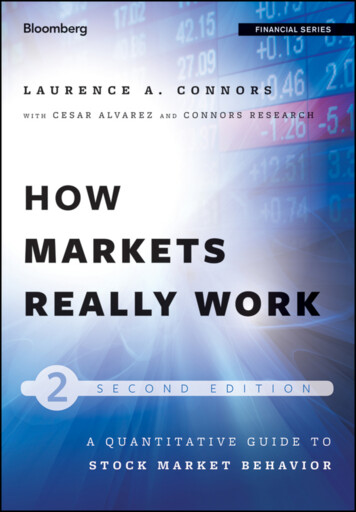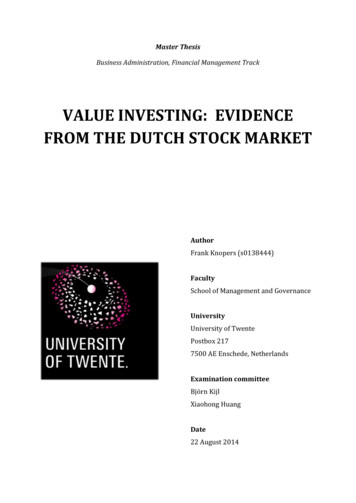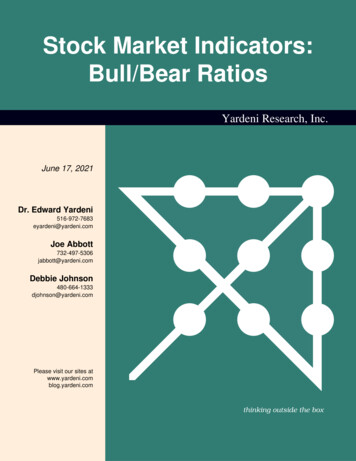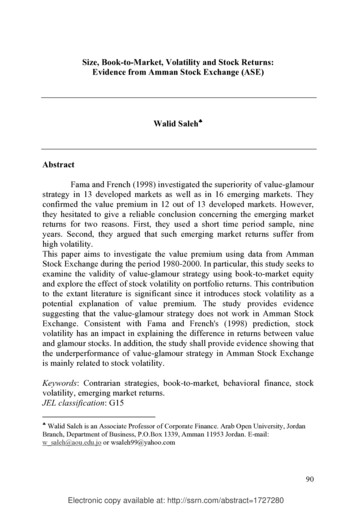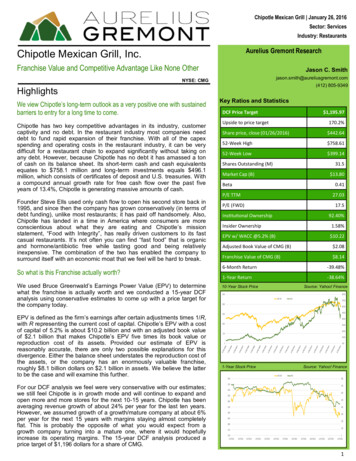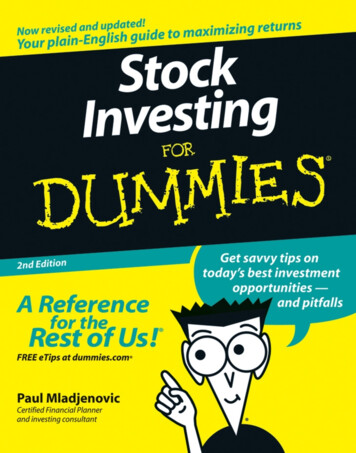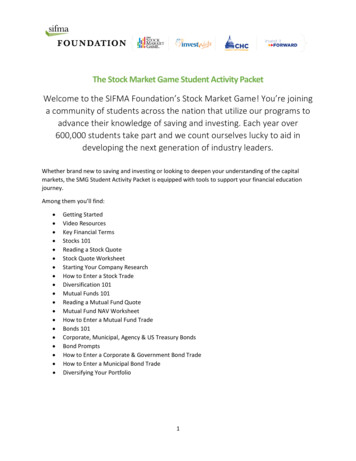
Transcription
The Stock Market Game Student Activity PacketWelcome to the SIFMA Foundation’s Stock Market Game! You’re joininga community of students across the nation that utilize our programs toadvance their knowledge of saving and investing. Each year over600,000 students take part and we count ourselves lucky to aid indeveloping the next generation of industry leaders.Whether brand new to saving and investing or looking to deepen your understanding of the capitalmarkets, the SMG Student Activity Packet is equipped with tools to support your financial educationjourney.Among them you’ll find: Getting StartedVideo ResourcesKey Financial TermsStocks 101Reading a Stock QuoteStock Quote WorksheetStarting Your Company ResearchHow to Enter a Stock TradeDiversification 101Mutual Funds 101Reading a Mutual Fund QuoteMutual Fund NAV WorksheetHow to Enter a Mutual Fund TradeBonds 101Corporate, Municipal, Agency & US Treasury BondsBond PromptsHow to Enter a Corporate & Government Bond TradeHow to Enter a Municipal Bond TradeDiversifying Your Portfolio1
Getting StartedYou may have received a Stock Market Game username and password from your teacher. If you did notreceive one, you can have a parent or other adult register at www.stockmarketgame.org to have onecreated for you.Your Stock Market Game username and password puts you in an investor’s shoes; allowing you theopportunity to manage a virtual 100,000 stock portfolio and invest in stocks, bonds and mutual funds.You can log-in to make trades online at www.stockmarketgame.org or through the Stock Market Gameapp, available on both the apple and google play stores.Sample Username: USA 20 ZZ123Sample Password: SMGABC123HOT TIP: Usernames and passwords are case sensitive and must include all characters, evenunderscores. Usernames cannot be changed, but feel free to change your password to whatever youlike. After logging in, click the “resources” tab at the top of the portfolio, click “change password” andfollow the prompts.Keep an eye out for these bars! They’ll let you know when it’s time to log into your SMG portfolio.Read thoroughly and pay attention while completing activities, they could be anywhere.What’s learning without a little social media? Follow us to get answers to your market questions, tips onnavigating the portfolio, watch videos on investing concepts and get insight directly from financialprofessionals!@SIFMAFoundation on Twitter, Instagram and Facebook and The Stock Market Game onYouTube!2
Video ResourcesCheck out our YouTube page (www.youtube.com/c/thestockmarketgameprogram) to view our 10 CoreMini-Lessons and other educational and tutorial videos. Make sure to subscribe to our channel forupdates!10 Core Mini-Lesson VideosLaunched this past Fall, our 10 mini-lessons are 3-6 mins each, cover a core investing topic, and wrap upwith a formative assessment. Chapter 1- Why is investing important? (4 mins)Chapter 2- What is a company? (3 mins)Chapter 3- What is a stock and ticker symbol? (4:30 mins)Chapter 4- Trading Portfolio Overview (6 mins)Chapter 5- How to Read a Stock Quote (6 mins)Chapter 6- Stock Research and Trading (5:30 mins)Chapter 7- The Rules (6 mins)Chapter 8- Diversification and Risk (5 mins)Chapter 9- What causes stock prices to change? (4 mins)Chapter 10- Buy, Sell or Hold? (4:30 mins)Click here to start watching the playlist!3
Key Financial TermsPortfolio: The group of assets—such as stock, bonds and mutual—held by and investor.Stock: A share of ownership in a business. A share of a company's profit (or loss) belongs to eachowner.Risk: The likelihood of losing money. Higher risk means a greater opportunity for high return and ahigher potential for loss.Diversification: A risk management technique that mixes a wide variety of investments within aportfolio. It is designed to minimize risk by combining different investments whose prices are not likelyto move in step with one another.Mutual Fund: A company owned by investors who pool their savings to invest in a variety of stocks orbonds managed by a professional.Dividend: A cash payment from profits announced by a company’s board of director’s and distributedamong stockholders. In the Stock Market Game, and dividends received are listed in Transaction Historyand are included in the portfolio’s total equity.NASDAQ: An electronic exchange where stocks are traded through an automated network ofcomputers instead of a trading floor. It stands for the National Association of Securities DealersAutomated Quotations System and is the largest electronic stock market in the U.S. and second largestin the world. The Nasdaq Composite index measures the change in more than 3,000 stocks.New York Stock Exchange (NYSE): The oldest and largest stock exchange in the United States. The NewYork Stock Exchange is located on Wall Street in New York City and is the largest equities-basedexchange in the world based on the total market capitalization of its listed securities. The total marketvalue of the roughly 2,300 companies whose shares are listed on the NYSE is about 5 trillion. It wasfounded in 1792.Public Company: A company with publicly traded shares that anyone can buy in the stock market.Private Company: A company that doesn't sell shares to the public. You can't buy shares of a privatecompany in the stock market.Dow Jones Industrial Average (DOW): The best-known measure of stock prices consisting of 30 large,well-known companies in major sectors of the U.S. economy.S&P 500 (Standard & Poor's 500): A popular measure of stock prices consisting of 500 large companiesthat represent the major sectors of the U.S. economy. One of the most commonly used benchmarks ofthe overall stock market.Market Capitalization (or Market Cap): The total current market value of all outstanding shares ofa company. Market capitalization is calculated by multiplying a stock's current price by the totalnumber of outstanding shares.4
Small capitalization stocks (Small Cap): A stock of a company whose market capitalization is small,usually under 500 million. Small-cap stocks tend to grow faster than larger cap companies, but theyalso tend to be more volatile (inconsistent, fickle, changeable).Mid Cap: Short for “middle cap,” mid cap refers to stocks with a market capitalization of between 2billion to 10 billon.Large Cap: refers to a company with a market capitalization value of more than 10 billion. Large cap is ashortened version of the term "large market capitalization.Beta: measure of the volatility of a security (stock) or a portfolio in comparison to the market as awhole. Break down – a beta of 1 indicates than the security’s price will move with the market. A beta ofless than 1 means that the security will be less volatile than the market. A beta greater than 1 indicatesthat the security’s price will be more volatile than the market. For example, if a stock’s beta is 1.2, it’stheoretically 20% more volatile than the market.P/E: the ratio for valuing a company that measures its current share price relative to its per shareearnings. Break down – the P/E ratio indicates the dollar amount an investor can expect to invest in acompany in order to receive 1.00 of that company’s earnings. If a company were currently trading at aP/e of 20 the interpretation is that an investor is willing to pay 20 for 1 of current earnings5
Stocks 101 1Stocks represent a share of ownership in a publicly held company. The stockholder has a claim on theassets of a company in exchange for the money paid to purchase the stock. As an owner, thestockholder is sharing the wealth AND the risk of ownership with other owners of the company. Nomatter how few shares of stock you own, you are part owner of the business.Typically, a company issues stock in order to raise money to expand and build their operations. Thecompany goes to a financial services firm that specializes in underwriting an initial public offering (IPO)of stock to help them with this process. The financial firm gives the company the money it needs toexpand, and issues stock. This stock is sold to the public in what is known as the secondary market.Stockholders, also called shareholders, are people who buy the stock.People buy stock to earn dividends and with hope of selling the stock at a higher price than theyoriginally paid. Stockholders may receive part of the company’s profits through dividends. Publiccompanies are not obligated to pay dividends, but most do. Stockholders have limited liability; that is,while they can lose the money they invested to buy the stock, they are not responsible for thecompany’s financial debts should the company fail.A stockholder should make investment decisions based on his/her “risk tolerance.” All investments havesome risk. A somewhat risky investment with great growth potential might be a good for someone whois 28 and financially stable, but not for someone who is 60 and plans on retiring in five years. A 28-yearold has time to regain losses before retirement; the 60-year old may not.Stocks are traded on stock exchanges. The two major U.S. exchanges are the New York Stock Exchangeand the NASDAQ. Both are located in New York City. Stocks usually trade in lots of 100; anything lessthan 100 called an “odd lot.” Stocks can range in price from a few dollars to hundreds of dollars pershare.A publicly traded company pays increased taxes in the form of corporate income tax. Each state has itsown rules regulating public companies. Public companies must also comply with rules and regulationsimposed by the securities industry as well as the federal Securities and Exchange Commission (SEC).They must also submit an annual report to the SEC outlining all their financial information.There are two types of stock, common and preferred. When you own common stock, your sharesrepresent ownership in the corporation. They give you the right to vote for the company's board ofdirectors, and benefit from its financial success. Some corporations issue preferred stock in addition tocommon stock. Preferred stocks often pay a fixed dividend on a regular schedule. The price of preferredstock tends to be less volatile than that of common stock. Preferred stocks tend to move with changinginterest rates. Unlike owners of common stock, owners of preferred stocks are not entitled to vote oncorporate matters.1SMG Source: 00AF1.pdf6
Reading a Stock Quote 2A stock quote provides you with pricing information. This information helps you determine whether astock is a good investment or not. Different financial news and research sites may organize their stockinformation differently but will provide essentially the same information. The example below is takenfrom a NYSE stock quote.CompanyThe name of the companyCurrent PriceThis is the current per shareprice of the stockSymbolThe company’s stock/ticker symbolPrice ChangePercent Price ChangeThis is the difference betweenThis is the difference in pricethe stock’s current price and its expressed as a percentagelast reported pricePrev CloseDay’s RangeThe previous close is the stock’s closing price onThe highest price and lowest price of the stock sothe previous trading dayfar todayOpen52wk RangeThe first trade of stock today is its opening priceThe highest price and lowest price of the stock sofar over a 52-week periodBidVolumeAn offer made to buy this stockThe total number of shares traded so far todayAskAvg Vol (3M)The price at which a seller wants to sell thisThe average of the total number of shares tradedcompany’s stockin the past three months1 y Target EstMarket CapThe median target price as predicted by analystsThe total current market value of all outstandingcovering the stockshares of a companyBetaP/EBeta measures volatility. A number less than 1A company’s closing price divided by its latestmeans less volatility and a number greater thanannual earnings per share1 means more volatilityNext Earnings DateEPSThe next time the company will report itsEPS stands for Earnings Per Share. It is aearningscompany’s profit or earnings divided equallyamong all the shares investors ownDiv & YieldA dividend is a payment many companies maketo its stockholders. Yield is the amount of cashthat returns to stockholders2SMG Source: 00AA1.pdf7
Questions to consider when investing in a company 3:3 What products or services does this company provide? Are there new products coming to themarket? What type of risk do you think you’re taking when you invest in this company? Why would you recommend investing in this company?SMG Source: 00AA3.pdf8
Stock Quote WorksheetName: Date:CompanyCurrent PriceSymbolPrice ChangePercent Price ChangePrev CloseDay’s RangeOpen52wk RangeBidVolumeAskAvg Vol (3M)1 y Target EstMarket CapBetaP/ENext Earnings DateEPSDiv & Yield9
Starting Your Company SearchSearch the top companies across indexes. Visit: finance.yahoo.com and select one of the indexes at thetop:Once you’ve reached the indexes page, click “components”. You now have a list of companies to startyour search!Some other suggestions:1. Think about products and services that you use or encounter every day. For example,Starbucks coffee, Apple iphones (and their cell-phone carriers), Ford cars, etc.2. What companies do you like?3. What companies they are growing/expanding (adding new stores or restaurants in newlocations)?4. What companies that are creating new products or services?5. What companies have been around for a longtime and offer a dividend (see vocabulary)?10
How to Enter a Stock Trade11
How to Enter a Stock Trade on The SMG App!12
Diversification 101 4Have you ever been told: Don’t put all of your eggs in one basket? Do you know what people meanwhen they say that? In the context of investments, it means invest in a variety of companies through amix of stocks, bonds, and funds. Investors do this to protect themselves from losing a lot of money whenthe economy is bad.For example, in tough financial time, people are less likely to buy new TVs and other electronic devices.The lack of business would lead to a drop in the stock prices of consumer electronics retailers like BestBuy. If you only had Best Buy stock in your portfolio, your entire portfolio would lose money.However, if you had stock in a company like Walgreens, that sells health and hygiene products as wellas dispenses prescription medication, you might not lose as much. This is because people will need tomaintain their health, regardless of the economy. Their steady business and stock price would protectyour investment portfolio from heavy losses.Take a look at this pie graph. Would you consider it diversified? Why or why not?4SMG Source: 00AA1.pdf13
Look at the following portfolios. Which of these is the most diversified? What led to your decision?14
Mutual Funds 101 5A mutual fund investor can make money in several ways: Funds earn income from interest or dividends on its investments and distribute it toshareholders in an income distribution (the frequency of distribution depends on the fund).Funds produce capital gains by selling securities at a profit, and distribute those capital gains toinvestors, usually at year end.Investors sell their shares of the mutual fund at a higher price than they paid for them.Types of Mutual FundsThere are many types of mutual funds for investors to choose from: balanced funds, stock funds, bondfunds, sector funds, money market funds, etc. Most mutual funds are open-end funds. This means thefund will usually sell as many shares as investors want to buy. If you sell shares of your open-end funds,you sell them back to the same mutual fund pool you bought them from. Sometimes, open-end fundswill stop selling shares to new investors when they grow too large to be managed effectively.There are some mutual funds that have been created with specific social goals. For example, companieswith environmentally friendly business practices, companies that are considered “family friendly”, andcompanies promoting diversity and equity.Look at the stocks your team has purchased or plan to purchase. What industries do they represent? Is ita broad range of different industries?List three mutual fund companies you would consider for your portfolio.Most financial news sitesprovide access to a list of “Top Funds” and news specific to mutual fund investors. You can also visit theTop Holdings section of your portfolio (found within the account holdings tab).1.2.3.5SMG Source: 00AA1.pdf15
Reading a Mutual Fund Quote 6Most financial news sites have a section devoted to mutual fund news and quotes. A mutual fund quoteis referred to as NAV. It is an acronym meaning: Net Asset Value. It represents the value of one share ofthis fund just like the price quote for a stock. NAV is calculated by taking the total value of the fund'sinvestments, subtracting its expenses and dividing by the number of shares in the fund. Unlike a stockquote, NAV is calculated once a day after the market closes at 4pm ET.The YTD (Year-To-Date) Return is the percentage increase or decrease in value for one share since thebeginning of the current calendar year.A mutual fund’s Expense Ratio is how much it costs to maintain the fund in proportion to the value ofthe mutual fund. Costs can include management fees, recordkeeping, and accounting and auditing fees.Net Assets represents to total amount of money invested in all available classes of the mutual fund.Mutual funds like stocks are issued in classes. Each class provides shareholders with specific rights.A mutual fund’s Holdings Turnover is the rate a mutual fund replaces its assets annually.Example of a NAV below:SMG Source: 00AA2.pdfScreenshot: https://finance.yahoo.com/quote/FEMKX?p FEMKX&.tsrc fin-srch616
Mutual Fund NAV Worksheet 7Name: Date:Fund NameNAVTickerYTD ReturnExpense RatioHoldings TurnoverBriefly describe the fund. What companies and industries is it invested? Is it invested in other assets inaddition to stocks?How has the fund performed over the last five years?What is the fund’s top three holdings?What is Morningstar’s opinion of this mutual fund? Morningstar is a financial services firm.Morningstar's research and recommendations are considered highly influential in the assetmanagement industry. Visit www.morningstar.com.Morningstar Rating (# of stars)Morningstar Risk RatingDo you believe this fund is a good investment? Explain.7SMG Source: 00AA3.pdf17
How to Enter a Mutual Fund Trade18
Bonds 101 8Use the story to find the meaning of the words below. Underline the meaning when you find it. BondIssuerInterestFace valueDefaultBonds are issued by corporations, governments and government agencies (like mortgage lenders, FannieMae and Freddie Mac) to raise large amounts of money. Just like any loan, the issuer (the organizationselling the bond), agrees to pay back the money borrowed on a set date and agrees to pay interest.Interest is money paid by the lender to the borrower in addition to the amount borrowed for use of themoney.Investors buy investment grade bonds because they are considered very safe investments. They areissued by corporations and governments who are considered very trustworthy. These issuers always paythe interest and the loan back when they promise. Of course, just like a friend can refuse or is unable topay all or part of an IOU an issuer can refuse or default on a bond, but it is unlikely this will happen whenyou buy investment grade bonds. Now we will learn about the safest kind of bonds: Investment gradebonds or those that
Mutual Fund NAV Worksheet How to Enter a Mutual Fund Trade Bonds 101 Corporate, Municipal, Agency & US Treasury Bonds Bond Prompts How to Enter a Corporate & Government Bond Trade How to Enter a
